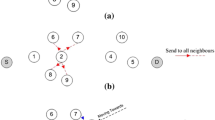Abstract
A new approach for routing protocols operating in MANETs is presented in which flooding is not required to establish paths from sources to destinations on demand in MANETs of moderate size. The concept of ordered walk is introduced as a depth-first search (DFS) that does not rely on geographical or virtual coordinate information and is much more efficient than mere random walks. The benefits of using DFS as the building block of the signaling in MANET routing protocols are exemplified by the introduction of the Ordered Walk Search Algorithm (OSA), which is used as part of the proposed Ordered Walk with Learning (OWL) protocol. OWL integrates OSA with the learning of paths from prior successful and failed attempts, and performs one or multiple concurrent ordered walks to search for destinations. Simulation experiments are used to compare the performance of OWL against that of well-known MANET routing protocols based on BFS (e.g., OLSR and AODV). The results show that OWL can achieve a performance comparable to traditional protocols that rely on some form of flooding of link states or network-wide dissemination of distance information in terms of packet delivery ratios and average end-to-end delays, while incurring up to ten times less overhead than AODV.










Similar content being viewed by others
References
Awerbuch, B. (1985). A new distributed depth-first-search algorithm. Information Processing Letters 20(3), 147–150.
Cidon, I. (1988). Yet another distributed depth-first-search algorithm. Information Processing Letters 26(6), 301–305.
Makki, S., & Havas, G. (1994). Optimal distributed algorithms for constructing a depth first search tree. In Proceedings of ICPP.
Tian, H., Shen, H., & Matsuzawa, T. (2005). Randomwalk routing for wireless sensor networks. In Proceedings of PDCAT.
Servetto, S. D., & Barrenechea, G. (2002). Constrained random walks on random graphs: Routing algorithms for large scale wireless sensor networks. Proceedings of WSNA.
Karp, B., & Kung, H. (2000). Greedy perimeter stateless routing for wireless networks. In Proceedings of the sixth annual ACM/IEEE international conference on mobile computing and networking, pp. 243–254, August.
Acer, U., Kalyanaraman, S., & Abouzeid, A. A. (2007). Weak state routing for large dynamic networks. In Proceedings of MobiCom, September.
Caesar, M., Castro, M., Nightingale, E. B., O’Shea, G., & Rowstron, A. (2006). Virtual ring routing: Network routing inspired by dht. In Proceedings of ACM SIGCOMM.
Dabideen, S., & Garcia-Luna-Aceves, J. J. (2009). OWL: Towards scalable routing in manets using depth-first search on demand. Sixth IEEE international conference on mobile ad-hoc and sensor systems.
Ni, S.-Y., Tseng, Y.-C., Hen, Y. S. V., & Sheu, J.-P. (2001). The boradcast storm problem in mobile ad-hoc networks. In Proceedings of MobiCom.
Segall, A. (1983). Distributed network protocols. IEEE Transactions on Information Theory.
Spohn, M. A. (2005). Domination in graphs in the context of mobile ad hoc networks. Ph.D. dissertation, University of California, Santa Cruz.
Kleinrock, L., & Kamoun, F. (1977). Hierarchical routing for large networks: Performance evaluation and optimization. Computer Networks 1(3), 155–174.
Guangyu Pei, M. G., & Chen, T.-W. (2000). Fisheye state routing in mobile ad hoc networks. ICDCS workshop in wireless networks and mobile computing.
Ramanathan, R., & Santivanez, C. (2001). Hazy sighted link state (hsls) routing: A scalable link state algorithm. BBM Technical Memo BBN-TM-I30I, BBN Technologies.
Xu, K., Hong, X., & Gerla, M. (2002). An ad hoc network with mobile backbones. IEEE international conference on communications.
Rubin, I., & Vincent, P. (2001). Topological synthesis of mobile backbone networks for managing ad hoc wireless networks. IEEE international conference on management of multimedia networks and services: Management of multimedia on the internet.
Beraldi, R., Querzoni, L., & Baldoni, R. (2006). A hint based probabilistic protocol for unicast communications in manets. Elsevier Ad Hoc Networks, 4(5).
Malkhi, D., Sen, S., Talwar, K., Werneck, R. F., & Wieder, U. (2009). Virtual ring routing trends. In Proceedings of the 23rd international conference on distributed computing.
Jacquet, P., Laouiti, A., Minet, P., & Viennot, L. (2001). Performance analysis of olsr multipoint relay flooding in two ad hoc wireless network models. INRIA, Technical report.
Clausen, T., & Jacquet, P. (2003). Optimized link state routing protocol (OLSR). RFC 3626, October.
Perkins, C. E., & Royer, E. M. (2003). Ad hoc on-demand distance vector routing. IETF Internet draft, October.
Kurkowski, S., Camp, T., & Navidi, W. (2006). Minimal standards for rigorous MANET routing protocol evaluation. Technical report MCS 06-02, Colorado School of Mines.
Navidi, W., & Camp, T. (2006). Stationary distributions for the random waypoint mobility model. IEEE Transactions on Mobile Computing 3(1), 1153–1166.
Acknowledgments
This research was partially sponsored by the U.S. Army Research Office (ARO) under grant W911NF-05-1-0246, by the U.S. Army Research Laboratory under the Network Science Collaborative Technology Alliance, Agreement Number W911NF-09-0053, and by the Baskin Chair of Computer Engineering. The views and conclusions contained in this document are those of the authors and should not be interpreted as representing the official policies, either expressed or implied, of the U.S. Government.
Author information
Authors and Affiliations
Corresponding author
Rights and permissions
About this article
Cite this article
Dabideen, S., Garcia-Luna-Aceves, J.J. Efficient routing in MANETs using ordered walks. Wireless Netw 17, 1095–1112 (2011). https://doi.org/10.1007/s11276-011-0339-6
Published:
Issue Date:
DOI: https://doi.org/10.1007/s11276-011-0339-6




